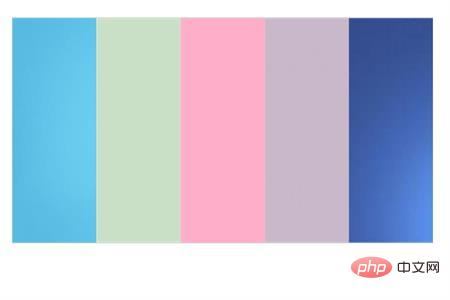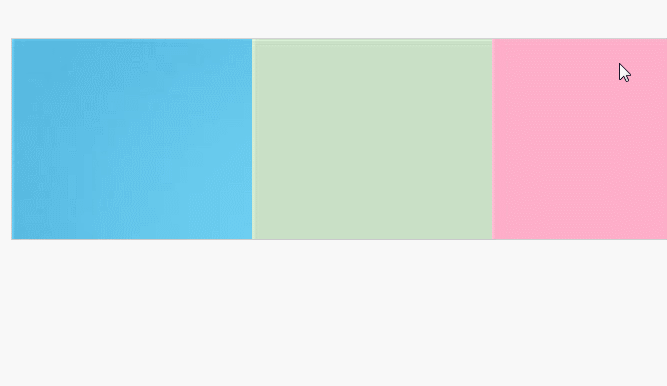How to achieve accordion effect with jQuery
In jQuery, the accordion effect is mainly achieved by setting the width of animate when the mouse slides in or out.
Today I will introduce to you how to use jQuery to achieve the accordion effect. That is, when the mouse enters, it will expand and when it slides out, it will become smaller.
[Recommended course: jQuery Tutorial】

Knowledge points required to achieve the accordion effect
(1) Traverse all the items through a for loop Picture, use the eq() method in jQuery to select the li tag and add a background image to it
eq(index) method: indicates the position of the element (minimum is 0), if it is a negative number, it will be from the last one in the collection Counting back one element.
$(".box>ul>li").eq(i).css("backgroundImage","url(image/"+(i+1)+".jpg)");(2) mouseenter(): When the mouse pointer slides into the element, an event will be triggered, that is, the function that is run when the mouseenter event occurs
(3) mouseleave(): When the mouse When the pointer leaves the element, an event is triggered, specifying the function to be run when the mouseleave event occurs. This event is most often used together with the mouseenter event.
(4) stop(stopAll,goToEnd): Stop the currently running animation.
stopAll: Whether to stop all queued animations of the selected element,
goToEnd: Whether to allow the current animation to be completed.
Both parameters are optional, but the goToEnd parameter can only be used when the stopAll parameter is set, and cannot be used alone
(5) siblings (selector): Get the matching set of each element and filtering by selector is optional.
selector refers to a string value that refers to the selector expression used to match elements.
(6) animate() method: Execute custom animation of CSS property set. This method changes the element from one state to another through CSS styles. Note that only numeric values can create animations, and string values cannot create animations.
Note: When writing animation, be sure to add stop() to stop the original animation to prevent animation overlap and affect the effect.
Complete code display
Document <script> $(function(){ for(var i=0;i<$(".box>ul>li").length;i++){ $(".box>ul>li").eq(i).css("backgroundImage","url(image/"+(i+1)+".jpg)"); } $(".box>ul>li").mouseenter(function(){ // 鼠标滑过时li的宽度为800,离开时为240 $(this).stop().animate({width:800}).siblings().stop().animate({width:100}).mouseleave (function(){ $(".box>ul>li").stop().animate({width:240}) }) }) }) </script>
Rendering

Animation Demonstration

Summary: The above is the entire content of this article. I hope that through this article, everyone can Learn how to create an accordion effect with jQuery.
The above is the detailed content of How to achieve accordion effect with jQuery. For more information, please follow other related articles on the PHP Chinese website!

Hot AI Tools

Undresser.AI Undress
AI-powered app for creating realistic nude photos

AI Clothes Remover
Online AI tool for removing clothes from photos.

Undress AI Tool
Undress images for free

Clothoff.io
AI clothes remover

Video Face Swap
Swap faces in any video effortlessly with our completely free AI face swap tool!

Hot Article

Hot Tools

Notepad++7.3.1
Easy-to-use and free code editor

SublimeText3 Chinese version
Chinese version, very easy to use

Zend Studio 13.0.1
Powerful PHP integrated development environment

Dreamweaver CS6
Visual web development tools

SublimeText3 Mac version
God-level code editing software (SublimeText3)

Hot Topics
 1672
1672
 14
14
 1428
1428
 52
52
 1332
1332
 25
25
 1277
1277
 29
29
 1257
1257
 24
24
 Detailed explanation of jQuery reference methods: Quick start guide
Feb 27, 2024 pm 06:45 PM
Detailed explanation of jQuery reference methods: Quick start guide
Feb 27, 2024 pm 06:45 PM
Detailed explanation of jQuery reference method: Quick start guide jQuery is a popular JavaScript library that is widely used in website development. It simplifies JavaScript programming and provides developers with rich functions and features. This article will introduce jQuery's reference method in detail and provide specific code examples to help readers get started quickly. Introducing jQuery First, we need to introduce the jQuery library into the HTML file. It can be introduced through a CDN link or downloaded
 How to use PUT request method in jQuery?
Feb 28, 2024 pm 03:12 PM
How to use PUT request method in jQuery?
Feb 28, 2024 pm 03:12 PM
How to use PUT request method in jQuery? In jQuery, the method of sending a PUT request is similar to sending other types of requests, but you need to pay attention to some details and parameter settings. PUT requests are typically used to update resources, such as updating data in a database or updating files on the server. The following is a specific code example using the PUT request method in jQuery. First, make sure you include the jQuery library file, then you can send a PUT request via: $.ajax({u
 In-depth analysis: jQuery's advantages and disadvantages
Feb 27, 2024 pm 05:18 PM
In-depth analysis: jQuery's advantages and disadvantages
Feb 27, 2024 pm 05:18 PM
jQuery is a fast, small, feature-rich JavaScript library widely used in front-end development. Since its release in 2006, jQuery has become one of the tools of choice for many developers, but in practical applications, it also has some advantages and disadvantages. This article will deeply analyze the advantages and disadvantages of jQuery and illustrate it with specific code examples. Advantages: 1. Concise syntax jQuery's syntax design is concise and clear, which can greatly improve the readability and writing efficiency of the code. for example,
 jQuery Tips: Quickly modify the text of all a tags on the page
Feb 28, 2024 pm 09:06 PM
jQuery Tips: Quickly modify the text of all a tags on the page
Feb 28, 2024 pm 09:06 PM
Title: jQuery Tips: Quickly modify the text of all a tags on the page In web development, we often need to modify and operate elements on the page. When using jQuery, sometimes you need to modify the text content of all a tags in the page at once, which can save time and energy. The following will introduce how to use jQuery to quickly modify the text of all a tags on the page, and give specific code examples. First, we need to introduce the jQuery library file and ensure that the following code is introduced into the page: <
 Use jQuery to modify the text content of all a tags
Feb 28, 2024 pm 05:42 PM
Use jQuery to modify the text content of all a tags
Feb 28, 2024 pm 05:42 PM
Title: Use jQuery to modify the text content of all a tags. jQuery is a popular JavaScript library that is widely used to handle DOM operations. In web development, we often encounter the need to modify the text content of the link tag (a tag) on the page. This article will explain how to use jQuery to achieve this goal, and provide specific code examples. First, we need to introduce the jQuery library into the page. Add the following code in the HTML file:
 How to remove the height attribute of an element with jQuery?
Feb 28, 2024 am 08:39 AM
How to remove the height attribute of an element with jQuery?
Feb 28, 2024 am 08:39 AM
How to remove the height attribute of an element with jQuery? In front-end development, we often encounter the need to manipulate the height attributes of elements. Sometimes, we may need to dynamically change the height of an element, and sometimes we need to remove the height attribute of an element. This article will introduce how to use jQuery to remove the height attribute of an element and provide specific code examples. Before using jQuery to operate the height attribute, we first need to understand the height attribute in CSS. The height attribute is used to set the height of an element
 Understand the role and application scenarios of eq in jQuery
Feb 28, 2024 pm 01:15 PM
Understand the role and application scenarios of eq in jQuery
Feb 28, 2024 pm 01:15 PM
jQuery is a popular JavaScript library that is widely used to handle DOM manipulation and event handling in web pages. In jQuery, the eq() method is used to select elements at a specified index position. The specific usage and application scenarios are as follows. In jQuery, the eq() method selects the element at a specified index position. Index positions start counting from 0, i.e. the index of the first element is 0, the index of the second element is 1, and so on. The syntax of the eq() method is as follows: $("s
 Introduction to how to add new rows to a table using jQuery
Feb 29, 2024 am 08:12 AM
Introduction to how to add new rows to a table using jQuery
Feb 29, 2024 am 08:12 AM
jQuery is a popular JavaScript library widely used in web development. During web development, it is often necessary to dynamically add new rows to tables through JavaScript. This article will introduce how to use jQuery to add new rows to a table, and provide specific code examples. First, we need to introduce the jQuery library into the HTML page. The jQuery library can be introduced in the tag through the following code:




